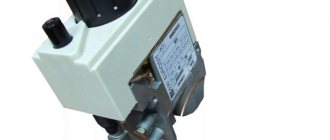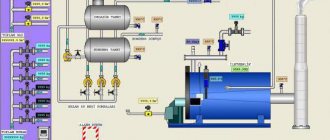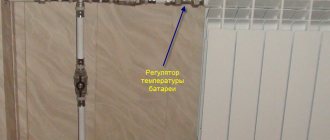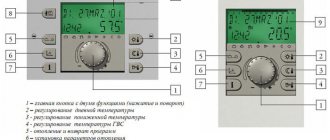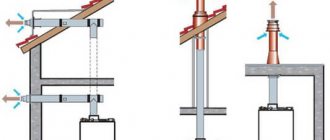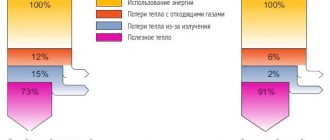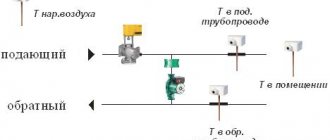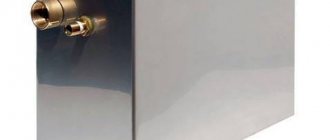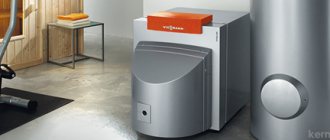Home / Boiler automation
Back
Published: 05/14/2019
Reading time: 3 min
0
904
We have long forgotten what stove heating is, when in order to heat the room it is necessary to take part in lighting the stove. Modern heating units used in everyday life can operate on gas, which is supplied in pipelines or delivered in cylinders. In this case, there is no need to systematically monitor ongoing operations; the fundamental principle of automation allows all actions to be carried out autonomously.
The process of combustion and maintaining the temperature of the coolant is ensured using various elements, which can be mechanical and electrical.
They are built into the equipment of floor-standing boilers at the manufacturing stage and provide completely autonomous operation. Automation designed for a gas boiler operates according to a certain principle that ensures a closed cycle.
- 1 Basic functions of boiler safety automation
- 2 Varieties
- 3 Design of devices and description of the principle of their operation 3.1 Mechanical sensors
- 3.2 Electronic devices
General provisions
Modern boiler houses require the installation of automatic systems that monitor, regulate and manage processes, and also report emergency situations. The automation project is based on SP 89.13330.2016 “Boiler installations”, individual requirements of the place of operation, manufacturer’s recommendations and building codes.
All automation is controlled from switchboards, which can be central, group or local. They should not be placed under showers and toilets, pipelines through which aggressive substances flow, or under ventilation chambers supplying hot air.
Equipment protection
Safety devices for liquid/gas fuel steam boilers stop the fuel supply when:
- the gas pressure in front of the burners decreases or increases;
- the pressure of liquid fuel in front of the burners decreases or increases, except for rotary burners;
- the vacuum in the furnace decreases;
- the air pressure in front of the burners decreases with its forced supply;
- the torches of those burners that should not be extinguished when the boiler is operating go out;
- pressure increases in automated boiler rooms that operate without the presence of specialists;
- the water level in the drum decreases or increases;
- the voltage disappears or other malfunctions of the protection circuits appear if we are talking about a boiler room of category II.
Safety devices for liquid/gas fuel boilers stop the fuel supply when:
- the gas pressure in front of the burners decreases or increases;
- the pressure of liquid fuel in front of the burners decreases or increases, except for rotary burners;
- the vacuum in the furnace decreases;
- the air pressure in front of the burners decreases with its forced supply;
- the torches of those burners that should not be extinguished when the boiler is operating go out;
- the water pressure at the outlet of the device decreases or increases;
- the voltage disappears or other malfunctions of the protection circuits appear if we are talking about a boiler room of category II.
For boilers with a maximum water temperature of 115°C, a decrease in water pressure and a decrease in its level are not a reason to change the fuel supply to the burners.
Safety devices for solid fuel steam boilers stop fuel supply when:
- the pressure behind the blower fans decreases;
- the vacuum in the furnace decreases;
- the torch goes out;
- the water level in the drum decreases or increases;
- the voltage disappears or other malfunctions of the protection circuits appear if we are talking about a boiler room of category II.
Safety devices for steam boilers with mechanized solid fuel layer combustion chambers stop the fuel supply when:
- the pressure under the grill decreases;
- the vacuum in the furnace decreases;
- the water level in the drum decreases or increases;
- the voltage disappears or other malfunctions of the protection circuits appear if we are talking about a boiler room of category II.
Safety devices for hot water boilers with mechanized layer and chamber fireboxes using solid fuel stop fuel supply when:
- the temperature of the water leaving the boiler increases;
- the water pressure at the boiler outlet increases or decreases;
- the vacuum in the furnace decreases;
- water consumption is reduced;
- the air pressure behind the blower fans or under the grille decreases.
For boilers with a maximum water temperature of 115°C, a decrease in water pressure and a decrease in its level are not a reason to change the fuel supply to the burners.
The need for additional equipment is determined individually, depending on the boiler parameter. For example, many manufacturers specifically state the safety requirements that must be met to operate the equipment safely.
High pressure heaters (HPH) must be automatically switched off if the level of condensate in the heater body rises above the permitted level.
Dust preparation systems must have the following protective functions:
- when the temperature of the drying agent increases, water is supplied to the shaft;
- when the temperature of the dust-gas or dust-air mixture behind the mill increases, the supply of the drying agent is stopped;
- if the fuel supply is stopped due to an accident, the vibrators are turned on;
- when the pressure in the box decreases, the air additive valves open.
Sulfuric acid pumps in water treatment plants are automatically turned off when the pH of the water drops.
The extent to which the parameters must be violated for the protection to operate is determined by the manufacturers of the protective equipment. Everything is in the instructions.
Operating principle of the SABC system
Despite the fact that the SABC gas automation is a complex device that requires fine adjustment, it is based on the simplest physical laws.
To understand the principle of operation of the system, familiarize yourself with its main elements:
- A control module on which a handle is installed that regulates the operating mode of the boiler. When the control knob is turned using a lever mechanism, the gas valve shutter is affected.
- A gas burner is an element that burns a flow of gas-air mixture.
- The pilot burner unit is responsible for igniting the main burner and provides protection against gas leakage.
- The draft sensor is a bimetallic plate that responds to changes in temperature in the combustion chamber. If the draft in the boiler deteriorates, the temperature in the chamber rises, the plate is deformed and affects the shut-off valve - the gas supply stops.
- Gas supply to the pilot burner.
- The flame sensor impulse tube transmits the action from the sensor to the control elements (gas valves).
- Pulse tube for draft sensor.
- A temperature sensor or flame sensor is a device that provides protection against gas leakage. The principle of its operation: under the influence of temperature from the ignition burner, the sensor acts on the shut-off valve, allowing it to open. If the sensor has cooled down, then there is no fire in the chamber. A pulse is sent to the shut-off valve to stop the gas supply.
How to choose between a gas and electric boiler, read here.
You can read about solid fuel boilers in an air heating system at the link -
Also read about boilers for heating greenhouses.
Signaling
Alarms are sound and light signals that are output to the control panel. The reasons for alarm activation in boiler installations without permanently present maintenance personnel are as follows:
- any equipment is faulty;
- the high-speed fuel shut-off valve has tripped;
- The level of gas contamination in a gas-fired boiler room has reached 10% of the minimum flammability of natural gas.
In boiler rooms with operating personnel present, the alarm is triggered in the following cases:
- the protection worked, the boiler turned off;
- the pressure or temperature in the pipeline with liquid fuel has decreased;
- gas pressure has decreased or increased;
- the water pressure in the return pipeline has decreased or increased;
- the water pressure in the supply lines has decreased;
- the water level in any tanks has increased or decreased, including deaerator, condensate, feed, etc.;
- the temperature of liquid additives in tanks has increased;
- the level of liquid fuel in tanks has increased or decreased;
- any installations supplying liquid fuel to the boilers have broken down;
- the temperature of electric motor bearings has increased;
- there is a vacuum in the deaerator;
- the pH value in the treated water decreased.
Types of hot water boilers and their automation
To ensure normal operating conditions, water heating boilers require automatic regulation and safety of the RBIP type, which stands for proportional integral non-contact regulator. The automatic safety system for gas boilers is a low-pressure safety valve, which is additionally equipped with an electromagnet. If the operation of the boiler is based on the use of fuel oil as fuel, then an automatic valve is used, which is installed at the point where the fuel is supplied to the furnace. Thus, boilers with a certain type of fuel require different types of safety equipment, so when purchasing units you should pay special attention to this. (See also: What you need to know about outdoor boilers?)
Valves in boilers can be controlled from a control panel remotely. Moreover, it has all the necessary locks. Thus, it is not possible to close the valve on the water pipeline until the valve on the gas pipeline is closed. Other actions that could disrupt the correct functioning of the system are also blocked, that is, the automation is fully responsible for the safe operation of the units, which reduces the risk of an accident to a minimum.
Automatic regulation
Automatic control of combustion processes can only be in boilers with layer mechanized and chamber furnaces that operate on liquid, solid and gaseous fuel.
But there are a number of cases when automatic supply and control of fuel combustion is not provided or may not be used. For example, steam boilers with steam pressure up to 1.7 kgf/cm2 can be refueled manually.
Dust preparation plants must have automated regulators that:
- load fuel into mills;
- the drying agent is thinned out before the mill;
- control the temperature of the dust-air mixture behind the mill.
In models with direct injection of dust into the firebox, a primary air flow regulator must be installed, as well as a mixture temperature regulator behind the mills - except for anthracite fuel.
The pipelines must have automatic pressure maintainers.
Deaerators must have regulators for steam and water pressure levels. Several deaerators must be combined into a single automatic system. Vacuum models must also have a device that will maintain the water temperature at a given level.
The supply of water from deaerators to accumulator tanks is usually not regulated, but intermediate tanks must be equipped with a water level regulator. Likewise, reduction units must have automatic pressure or pressure and temperature regulators, if we are talking about reduction-cooling units. There are enough cooling devices that will control the temperature of the steam. Heaters must be equipped with condensate level regulators.
Also, every boiler room should have an automatic system that will monitor and maintain the preset temperature of the incoming and return water.
In water treatment plants the following parameters are automatically regulated:
- water level in tanks - both clarified and decarbonized;
- source water heating temperature;
- consumption of reagents, while their automatic replenishment may not be possible.
The consumption of reagents is automated when installing filters with a diameter exceeding 2,000 mm.
Types of automatic security systems
The following systems are most often used in gas-type heating equipment:
- Ionization sensor. The device turns off the gas supply when the burner flame goes out.
- Limit level control device. The system signals that there is insufficient liquid in the boiler.
- Thermometer. Allows you to control the temperature of the coolant.
- Traction sensor. The device is designed to control the draft level in the firebox.
- Gas pressure sensor. The device allows you to control the pressure of flammable gas in the supply pipe.
In addition to the listed sensors, boilers with automatic control are equipped with computer processor algorithms, which are activated in the event of clearly erroneous actions on the part of the operator.
